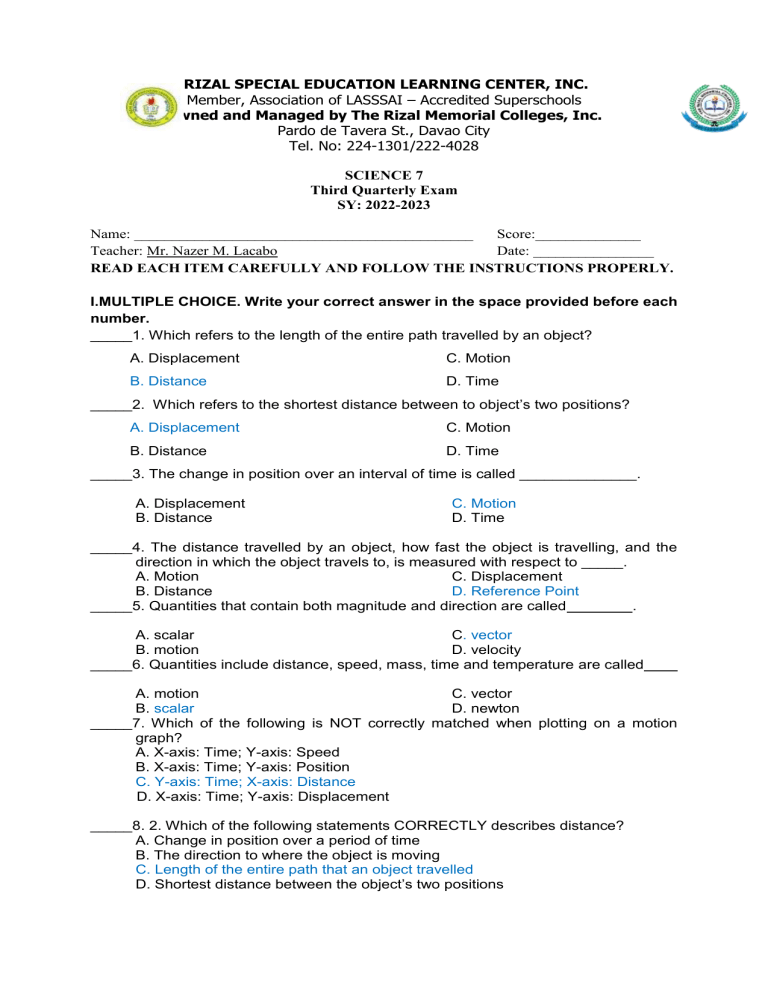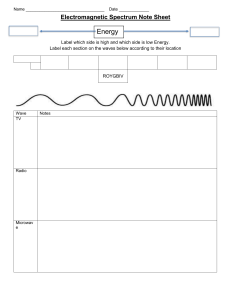
RIZAL SPECIAL EDUCATION LEARNING CENTER, INC. Member, Association of LASSSAI – Accredited Superschools Owned and Managed by The Rizal Memorial Colleges, Inc. Pardo de Tavera St., Davao City Tel. No: 224-1301/222-4028 SCIENCE 7 Third Quarterly Exam SY: 2022-2023 Name: _____________________________________________ Score:______________ Teacher: Mr. Nazer M. Lacabo Date: ________________ READ EACH ITEM CAREFULLY AND FOLLOW THE INSTRUCTIONS PROPERLY. I.MULTIPLE CHOICE. Write your correct answer in the space provided before each number. _____1. Which refers to the length of the entire path travelled by an object? A. Displacement C. Motion B. Distance D. Time _____2. Which refers to the shortest distance between to object’s two positions? A. Displacement C. Motion B. Distance D. Time _____3. The change in position over an interval of time is called ______________. A. Displacement B. Distance C. Motion D. Time _____4. The distance travelled by an object, how fast the object is travelling, and the direction in which the object travels to, is measured with respect to _____. A. Motion C. Displacement B. Distance D. Reference Point _____5. Quantities that contain both magnitude and direction are called . A. scalar C. vector B. motion D. velocity _____6. Quantities include distance, speed, mass, time and temperature are called A. motion C. vector B. scalar D. newton _____7. Which of the following is NOT correctly matched when plotting on a motion graph? A. X-axis: Time; Y-axis: Speed B. X-axis: Time; Y-axis: Position C. Y-axis: Time; X-axis: Distance D. X-axis: Time; Y-axis: Displacement _____8. 2. Which of the following statements CORRECTLY describes distance? A. Change in position over a period of time B. The direction to where the object is moving C. Length of the entire path that an object travelled D. Shortest distance between the object’s two positions _____9. A speed-time graph shows a horizontal straight line above the x-axis. What does this indicate? A. The object is slowing down. B. The speed does not change. C. The object is increasing in speed. D. There is an increase in the distance travelled _____10. Which of the following correctly describes a wave? A. It can set an object into motion B. It moves through materials only. C. It transmits weaker force D. It is static _____11. The following are electromagnetic waves, EXCEPT A. Infrared B. Gamma rays C. Sound D. X-rays _____12. What type of wave needs a medium to propagate? A. Electromagnetic waves B. Mechanical waves C. Microwaves D. Ultraviolet _____13. Which type of wave is characterized by the parallel motion of the particles in the wave to the wave propagation? A. Electromagnetic B. Longitudinal C. Mechanical D. Transverse _____14. Earthquake (seismic) waves are felt through the grounds. Are these waves electromagnetic in nature? A. Yes, because these need medium in order to propagate. B. No, because these do not need medium to propagate. C. No, because these are mechanical waves. D. Yes, because this carry energy. _____15. Marky is doing an experiment. He throws a piece of stone in a pond. Does he observe a wave? A. Yes, he observes that when stone touches water it moves back and forth. B. Yes, he observes that when the stone touches the water, circular ripples are formed. C. No, he observed that when stone hits water it does not produce wave. D. No, he does not observe wave when the stone touches water II.MODIFIED TRUE or FALSE DIRECTION: Write true if the statement is accurate. If false, change the underlined word/s that make it false and write the correct word/s. 16-17.The vibratory systems involves the diaphragm, chest muscle, rib cage, abdominal muscles, and lungs. Air pressure system 18-19.The air pressure system involves the larynx and the vocal folds. Vibratory systems 20-21.The resonating system involves the throat (pharynx), oral cavity, and nasal passages - collectively called the vocal tract. True 22-23. Infrasound or infrasonic waves are horizontal waves with frequencies ranging below the audible range. False-longitudinal 24-25. Audible sounds are longitudinal waves with frequencies ranging from 20 Hz to 20 000 KHz. False-20 Hz to 20,000 Hz 26-27. Ultrasound or ultrasonic waves are longitudinal waves with frequencies above the audible range. False-below II. IDENTIFICATION Direction: Identify the terms described in each of the following items. For items 28-30, refer to the illustration below. Suppose two identical kinds of light sources, A and B, shines on a surface of a board when placed 100 cm to the left and 50 cm to the right of the board, respectively. 28. Will the light intensity measured on the cardboard facing light source A is higher than the side facing light source B? No, because light source A is farther from the cardboard than light source. 29. How does the amount of light intensity of light source B compare to light source A as measured on the surface of the cardboard? The side facing light source B has greater light intensity. 30. What describes the brightness of light sources A and B? Light source B is brighter than light source A. Light sources A and B produce unequal brightness. 31. The range of energy-carrying waves arranged in order of lowest to highest frequency is known as the . (Electromagnetic spectrum) 32. Are commonly used in transmitting or receiving signals through cellular phones. . (Radio wave) 33. The transfer of thermal energy from a hot object to a cold object. . ( Heat) 34. Takes place when two objects reach the same temperature, and there is no transfer of thermal energy anymore. . (Thermal equilibrium) 35. The measure of the average of kinetic energy of molecules in an object or matter. . (Temperature) 36. A wave where the motion of the particles in the medium is parallel to the direction the wave travels. . (Longitudinal wave) 37. A disturbance that requires a medium to transfer energy from one place to another. . (Mechanical wave) 38. A type of wave that does not need any medium for them to propagate. . (Electromagnetic wave) 39. A wave where the motion of the particles in the medium is perpendicular (or at a right angle) to the direction the wave travels. . (Transverse wave) 40. A disturbance that travels through a medium or space. 41. It is the source of any sound waves. . (Wave) .(vibration) 42. It refers to the high-density region produced by a vibrating object. .(compression) 43. It is the ability of an object to change its shape once a force is applied and to go back to its original shape once the force is removed. (elasticity) 44. It is the bouncing back of sound waves. ( echo) 45. It refers to the ability of sound waves to change direction when it passes through a small opening or a barrier. .(diffraction) III. ESSAY Direction: Write 5-10 sentences. The rubrics will be used to rate your answer. RUBRICS 5-has a strong central idea that is related to the topic. 4-has a few grammatical and spelling errors that do not distract from the over-all message. 3-uses common words accurately, but sentences tend to be simplistic and unsophisticated. 2-has one or two severe grammatical errors. 1-lack of a central idea. 45-50. Explain the importance of earthing or grounding.







